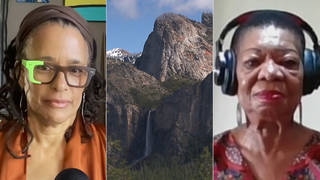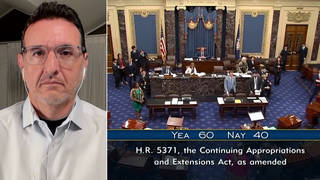
Guests
- Michael McDonaldAssociate Professor at George Mason University in Virginia. He is a redistricting expert and leads the United States Elections Project. He is also a senior fellow at the Brookings Institution.
The midterm election could impact the country’s political landscape for years to come as states prepare to redraw congressional districts for the first time in a decade. Republicans now hold more state legislative seats than they have since 1928 after winning 600 state legislative races, nineteen legislative chambers, and twenty-one governor’s seats. These gains will have a big impact when state lawmakers begin to decide how to redraw the district boundaries for the US House of Representatives. To explain these changes, we are joined by Michael McDonald, a redistricting expert at George Mason University. [includes rush transcript]
Transcript
JUAN GONZALEZ: Tuesday’s midterm election is shaping up to be historic for Republicans on the state level, and the results could impact the country’s political landscape for years to come as states prepare to redraw congressional districts for the first time in a decade. Republicans won more than 600 state legislative races and took control of at least nineteen legislative chambers across the country. In addition, Republicans won twenty-one governor’s seats, with Democrats grabbing eight.
According to the National Conference of State Legislatures, the Republicans now hold more state legislative seats than at any time since 1928. In North Carolina and Alabama, Republicans control the legislature for the first time since Reconstruction. In Minnesota, they control the State Senate for the first time ever. And in the key swing state of Ohio, Republican John Kasich ousted Democratic Governor Ted Strickland, and Republicans seized Ohio’s lower house.
AMY GOODMAN: And the closely watched governor’s race in Vermont has been decided. Democrat Peter Shumlin claimed victory after Republican Brian Dubie conceded the race.
These gains by Republicans will have a big impact when state lawmakers begin to decide how to [redraw] the district boundaries for the House of Representatives. To talk more about this, we’re joined by Michael McDonald, associate professor at George Mason University. McDonald has written extensively on the redistricting process and has worked as an adviser to the US Election Assistance Commission. He also helps run the Public Mapping Project website.
Welcome to Democracy Now!, Michael McDonald. Explain what redistricting is, how significant it is, and what these new elections mean.
MICHAEL McDONALD: Yeah, well, periodically, we redraw our district boundaries, and this is ostensibly to equalize population. This is a requirement that’s in, essentially, the federal Constitution. And I say “ostensibly” because what really goes on is that the boundary lines are manipulated to either help political parties or particular incumbents win their elections. And so, although we had an election this last — a couple days ago, much of what goes on behind the scenes in determining where these district boundary lines are drawn really has a great influence on the choices that are presented to the public and who is likely to win in a particular area, a state or a district. And so, redistricting has just a huge influence over the entire course of the decade as to who is going to be likely to be running for the different districts and to represent you across the country.
JUAN GONZALEZ: Now, in previous redistricting efforts, there have been huge battles that have erupted. I remember after the 1990 census, there was many battles over the question of the Supreme Court actually having to rule on the creation of majority minority districts. And then in — after 2000, you had the big battle in Texas over many of the congressional districts that were redrawn by Republicans that were aimed at really removing many Democrats from being able to get into Congress. What do you envision will happen, the major battlegrounds that will occur, this time around?
MICHAEL McDONALD: Well, the losers of redistricting often go to court. And so, the political parties understand that this is very important. So they put a lot of resources into this. They will do a lot during the redistricting process. And then, if they don’t get district lines that are favorable to them, they’re going to go to court. So this is just kind of a natural landscape that we’ve seen since the 1960s, since the courts really got involved in redistricting.
And so, this time around, we will probably see more litigation, because it’s just the way that things happen here, and both parties are gearing up fundraising machines to ensure that they will have the resources to do litigation. And if we look across the states, we are likely to see litigation related to the Voting Rights Act, because there’s been a bit of uncertainty with some rulings over the past decade and a reauthorization of the Voting Rights Act in 2007. The states are going to want to test out what the limits are of racial gerrymandering. And so, very likely we’ll see some sort of court action there.
We’ll likely also see states try and change the definition of “population.” And this is very important because districts have to be of equal population. But there’s a little bit of wiggle room here. Some states, for example, are redistributing felon populations out to — from where they are currently residing, in prisons, to other areas of the state. That’s likely to be litigated. So, places like Maryland and New York, among others, are states that have passed that law. And other states are going to be looking at potentially also changing the base of population maybe to citizens. And so, I foresee some litigation along that line.
And then, finally, in a state like Florida, just passed an initiative by voter referendum, and it was really amazing that they did so, because they needed 60 percent of the vote to do it. And that initiative sets a list of state criteria for drawing redistricting. So there’s some federal criteria about equal population in the Voting Rights Act. Then there’s some state criteria. And what we’ve seen is, over since 1990s, a proliferation of the state criteria and lawsuits that are really aimed at making districts comply with the state criteria. And so, I feel like a state like Florida, in particular, because the stakes are going to be so high in that battleground state and Republicans won so many seats down there, that the Democrats are likely going to be challenging whatever the state government does on redistricting with this new set of criteria.
And you’re going to see much similar sorts of things elsewhere. But I would say that in congressional redistricting, usually states have a free rein to do whatever they want to do. It’s more in state legislative redistricting that we see criteria being applied by states in addition to the federal criteria. So there are only a few other opportunities for state lawsuits about state criteria in other states.
JUAN GONZALEZ: And Michael McDonald, of course the main demographic trend in the United States now for, I guess, several decades now has been the increasing growth of population in the Southwest and the West vis-à-vis the shrinking percentage of the population in the East and the Northeast. And obviously the Southwestern states will gain — will gain, and the Western states will gain congressional seats, while they’ll be taking them from the East and Northeast. And it’s precisely in the Southwest where you’ve had this huge explosion of the Latino population in the country. So how do you see this — the issue of racial gerrymandering affecting what happens in places like Arizona, Nevada, New Mexico, California and Texas?
MICHAEL McDONALD: Well, Texas and Arizona and parts of California are covered under what’s called Section 5 of the Voting Rights Act. And Section 5 says that these jurisdictions — not all, just some, and it includes the three I just listed — they cannot diminish the opportunity for minorities to elect candidates of their choice. So the number of minority districts that currently exist in those states, you have to keep that number in the next redistricting. So that’s —- Section 5 is a very important part of what’s going to be happening over the next year or so with redistricting. The other very important -—
JUAN GONZALEZ: And that would mean — and that would mean that the Justice Department has to pre-clear any redistricting that the states decide on?
MICHAEL McDONALD: Yeah, the procedure is that a state will draw a redistricting plan, and then the Department of Justice or District Court of DC will then clear that or pre-clear that map for use. And so, that’s the components under Section 5, which are very important. And they also apply to other Southern jurisdictions for — mainly for African American voting rights concerns, but also because of growing Latino populations in states like Florida. They also apply to Latino populations there. So Section 5 is very important.
But I do want to mention Section 2, which is — applies everywhere in the country. And Section 2, there are three criteria. One is that the minority population is large enough to draw a district around, that the minority population is drawing — it votes for candidates of their choice, and the white population votes for candidates that are not the minority-favored candidates. And if you have those three conditions in place, then the Voting Rights Act says you must — you must — draw a district to help minorities elect a candidate of their choice. So, in a state like Texas where the Latino population has grown considerably, first under Section 5, they are going to have to draw at least the same number of minority districts as they currently have, and then, in addition to that, they may, under Section 2, have to draw additional districts. And we’re just going to have to monitor this. We won’t know until the Census Bureau begins releasing population data in February of next year whether or not these Latino populations are large enough to draw these districts around. And if they are and if these other conditions about voting exist, then you must draw a Latino district.
AMY GOODMAN: Michael McDonald, can you also talk about the redistricting reform ballot measures approved Tuesday by voters in California and in Minnesota?
MICHAEL McDONALD: Well, in California, we — in 2008, we had an initiative that was adopted by the voters that applied to the state legislature. And that — in 2010, there were two initiatives on the ballot. One would undo that initiative. That one failed spectacularly. And then there was another one that would extend the commission’s responsibilities to congressional redistricting. And so, that one passed overwhelmingly, as well. So now, although the Democrats gained control of the state government in California, they did not gain control of the redistricting process there, which is very important, because when you look across the landscape, that was fifty-three or fifty-four districts that were taken off the table for the Democrats to gerrymander, and you’re going to see many other gerrymanders going on by Republicans in states like Florida and Pennsylvania and Ohio and Michigan, these large battleground states that — where Republicans have unified control.
Now, I hate to say, I’m not very familiar with what happened in Minnesota —
AMY GOODMAN: Voters in Minneapolis approved — voters in Minneapolis approved a referendum that removes political parties from the redistricting process.
MICHAEL McDONALD: Oh, alright, so it’s a local initiative. And, yeah, there’s been a move to adopt commissions. California is a good example of this. And that initiative — similar initiatives been on the ballot elsewhere. So, it sounds good to me, because of — there’s a real potential here for self-abuse, of politicians drawing districts for themselves, and they will cut off —- cut out their opposition. So they -—
AMY GOODMAN: So political parties will not be allowed to choose people to the redistricting commission; it will be a judge that does it?
MICHAEL McDONALD: Yeah. And that’s interesting because each state has their own way of doing this. So California has a citizen commission, where citizens apply to be a part of the commission, they’re vetted, and there’s a very complex selection procedure there. What Minnesota — and I’ve worked with reformers in Minnesota at the state level on reforms — and what Minnesotans like is they like their judges. They have a tradition of respect for their judiciary. And so, you get — you know, different states look at their own political culture. In California, they want citizens to do redistricting, or at least be responsible for it; in Minnesota, there’s more trust and faith put into judges.
AMY GOODMAN: Michael McDonald, we want to thank you very much for being with us, redistricting expert at George Mason University in Virginia.
This is Democracy Now!, democracynow.org, The War and Peace Report. Very close race in Tucson. We’re going to be speaking with the co-chair of the Progressive Caucus, who appears to have survived his challenge, but the final numbers are not in that. Raúl Grijalva will join us next. Stay with us.













Media Options